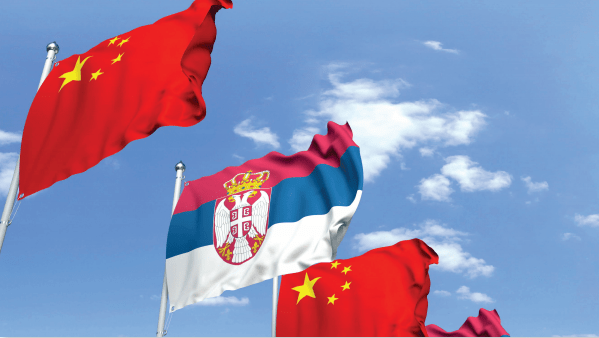
With the launch of Belt and Road initiative back in 2013, China has become one of the most important actors in the field of international relations. Belt and Road initiative enabled China to increase its presence in different regions around the world, reaching out to several continents, including Europe.
One of the regions where China has increased its presence is Western Balkans. China has established cooperation with several Western Balkans countries and through that cooperation it can be shown that consequences coming from cooperation with China could be both positive and negative.
Serbia has become the poster child of cooperation with China in the Western Balkans. Several preconditions enabled China to become one of the most important partners of Serbia, both in the field of international relations and in internal affairs. One of the preconditions is the heritage of communism as a socio-political order. And while both countries have moved on from the original version of communism it has been defined as historical determinant of relations between two countries. Second precondition is political support that China has provided to Serbia in the field of international relations. China didn’t support NATO intervention on the territory of Yugoslavia in 1999. Additionally, China has not recognized Kosovo as independent country, and that makes China one of the two permanent members of United Nations Security countries that didn’t recognize it. On the other hand, Serbia has been supporting the ‘One China’ policy. Since 2009, Serbia has hosted the highest level Chinese officials two times. First one was the visit of Chinese Prime-minister Li Keqiang in 2014 during the 16+1 summit that Serbia hosted, and the second one was the bilateral visit of Chinese leader Xi Jinping in 2016. Chinese presence in Serbia is well welcomed, both from political elites and from general public, and it is often described as ‘steel friendship’ between two countries. Besides political cooperation, Serbia has been developing its relations in the sphere of economy, culture and security.
The significant rise of cooperation between two countries has started in 2009 when Chinese and Serbian officials have signed the strategic document that was base ground for future cooperation in the infrastructural projects and economical cooperation overall. Since then, Serbia and China have reached and implemented several financial agreements that have enabled joint projects in the field of infrastructure and energy. Using Chinese money, provided through loans from Chinese state banks, Serbia has constructed bridges, parts of railroads, highways and improved existing power plants. Those were not foreign direct investments, but loans that Serbia has gotten from China and that will be paid back. The number and total sum of loaned money raised concerns that Serbia could fall in ‘debt trap’ like some other countries that had financial agreements with China did. For now, Serbian cooperation with China was beneficial, but there is a raising concern that with the rising Chinese presence negative consequences could come in long term.
Beside raising number of financial agreements, we are witnessing the rising number of Chinese foreign direct investment in Serbia. First one came in 2019 when Chinese company purchased assets of Smederevo steel plant in Serbia. It has continued with the purchase of smelting and mining combine Bor. The biggest Chinese Greenfield investment so far was the Shandong Linglong tire factory in Zrenjanin.
Still, even with the rising number of Chinese foreign direct investments, they are not even close to the foreign direct investments coming from European Union member countries. Also, foreign trade between China and Serbia is far from the level of foreign trade between Serbia and European union countries.
Still there are rising concerns that rising cooperation with China could distance Serbia from joining the European Union. The reason for that is doubt that with the rising level of economic cooperation, Chinese political influence could follow, and if Serbia becomes the member of European Union, that impact could be carried over to Europe.
European Union representatives have already expressed their concerns that Western Balkan countries could become the ‘Trojan horse’ of Chinese influence. Besides Serbia, that is experiencing mostly positive and beneficial consequences of cooperation with China, Montenegro was on the verge of falling into the ‘debt trap’. Montenegro reached financial agreement that would be used for construction of partition of the highway from Adriatic Sea to border with Serbia. It impacted hard Montenegro’s foreign debt, and they had to make big moves in the international financial market to avoid it. It showed that cooperation with China does come without negative consequences if country is not careful, and it additionally raised concerns that cooperation with China can be harmful.
North Macedonia has also reached agreement with China for the construction of highway. Like Serbia, Macedonia is a transit country for Chinese goods from Piraeus port to European market. Piraeus port is under the management of China, and it is important strategic and entrance point of China in Europe. Highway through North Macedonia, and Serbia would connect the Piraeus port with Belgrade-Budapest railroad, which is also being upgraded with the help of Chinese loans. European Commission raised concerns that competition rules were not followed while choosing the companies that will be working on the construction of railroad. And while Hungary had to re-evaluate the project, since it is under direct control of European Union control mechanisms, Serbia did not have those problems. But, if Serbia becomes the member of European union, the oversight and control of agreements with China will be significantly higher.
China has also been providing funds for construction of thermal power plant in Bosnia and Herzegovina, and there is possibility of rising presence in that Western Balkans country also. Since China is not recognizing Kosovo as an independent country, it did not developed relations with that country and besides that it doesn’t have significant level of cooperation with Albania, even though there are historical preconditions for the cooperation between those two countries.
And while there is no doubt that China has become the important factor in the Western Balkans, especially in Serbia, there are several challenges for the future of cooperation between Western Balkan countries and most populous country in the world. All of the Western Balkans countries have been declaring willingness to continue their path towards membership in European Union. In that sense, future of Western Balkan’s countries cooperation with China lies also in the relationship that European Union will have with China. With rising concerns of European Union that Chinese presence in the Western Balkans and its influence will come with negative consequences. Still the future of European integration of Western Balkans is not clear and certain, and that leaves space for new actors to step in. And maybe the consequences of cooperation with those actors will be negative. The possibility for negative consequences lies in the lack of control mechanisms, dependence on political elites and unstable state institutions of Western Balkans countries. Those possibilities could be removed if the Western Balkans countries become the part of European Union.
The future of cooperation between China and Western Balkans countries lies in the result of the process of European integration of those countries. Since it is clear that none of the Western Balkans countries will become the members of the European Union soon, there are good conditions to further strengthen the levels of cooperation with China in different spheres. Political cooperation, cooperation in the sphere of economy, cultural cooperation even security cooperation makes China important factor in the Western Balkans and it will become even more important if Western Balkans countries do not become part of the European Union.
This article is first published in the fifth issue of Eurasian World publication, published by Center for Eurasian Studies, Turkey












